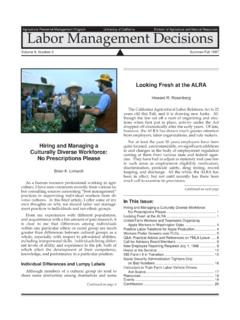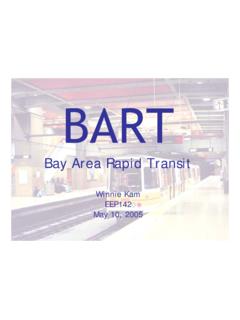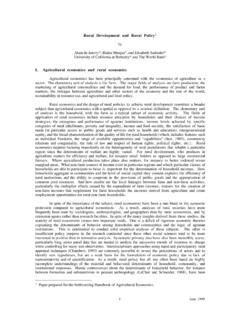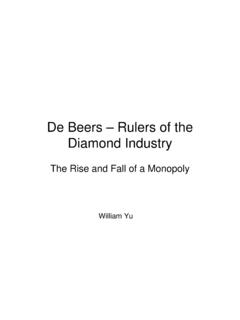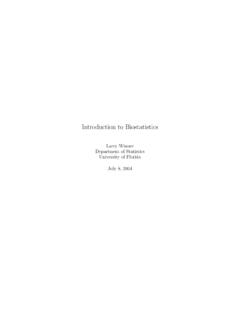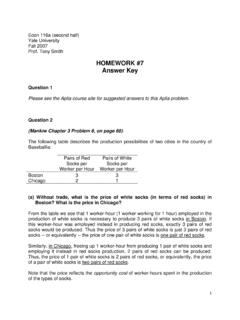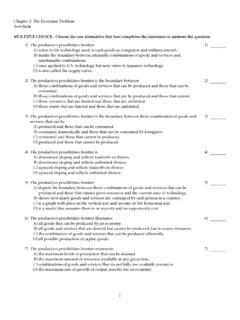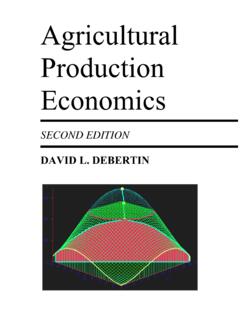Transcription of Lecture 2a: Ricardian Model part 1
1 Lecture 2a: Ricardian Model part 1 Thibault FALLYC181 International TradeSpring 2018In this chapter we will examine the following topics: Brief summary of reasons to trade and specialize Brief history of Ricardian Model Ricardian modelIn this chapter we will examine the following topics: Brief summary of reasons to trade and specialize Brief history of Ricardian Model Ricardian Model : PPF Autarky equilibrium Export patterns Wages International prices Equilibrium with international trade Gains from trade in the Ricardian modelReasons countries trade with each other include: Differences in the technology used in each country Differences in the total amount of resources (including labor, capital, and land) Differences in tastes Imperfect competition, product differentiation1 Reasons for TradeReasons countries trade morewith some countries than others include.
2 Proximity of countries to each other Low communication/coordination costs Low bilateral tariffs and FTA, Reasons for TradeResources Natural resources ( land and minerals) -Includes energy resources ( coal, petroleum) Labor resources (by skill level) Capital (machinery and structures)Vocabulary:Resources = Factors of production = Endowments 1 Reasons for Trade Comparative AdvantageA country has a comparative advantage in producing those goods that it produces best compared with how well it produces other a country has the best technology for producing a Two aspects.
3 Absolute advantage1 Reasons for TradeComparative AdvantageWhile Napa has a comparative advantage in growing regular grapes, Canada now has a comparative advantage in making ice wine May depend both on technics and resources1 Reasons for TradeLeads to different models:1 Reasons for Trade Ricardian Model focuses on differences in technology (chap 2) Heckscher-Ohlin Model (chap 4-5) focuses on differences in endowments Specific-factor Model (chap 3) is a mixture of the two models Krugman Model (chap 6) focuses product differentiation (product-level specialization)Mercantilism: exporting is good : generates gold and silver for the national treasury Importing is bad because it drained gold and silver Mercantilists were in favor of high tariffs to obtain low imports and high exports.
4 This theory does not account for general-equilibrium effectsInstead, Ricardo shows that countries can benefit from balancedinternational trade without having Ricardo (1772-1823) and Mercantilism(see article posted in the further readings folder) Old Model , but still highly relevant today!(actually more than Krugman s Model !) Most simple Model to illustrate effect of trade(simple yet subtle and not obvious)[PS: Paul Krugman was an economist specialized in Trade (Nobel in 2008) before becoming a New York Times columnist]P. Krugman: why teach Ricardo?
5 That it is logically true need not be argued before a mathematician; that it is not trivial is attested by the thousands of important and intelligent men whohave never been able to grasp the doctrine for themselves orto believe it after it was explained to them. Paul Samuelson, Nobel Prize Laureate in 1970[That was a response to a mathematician: Name me one proposition in all of the social sciences which is both true and non-trivial. ]P. Samuelson about comparative advantage:2 Ricardian Model SetupTwo goods: Wheat (a major exports of the and Europe) Cloth (major import)For now: No land, no capital Both goods are produced with labor : See chapter 3 & 4 for Model with Capital and LandWe also assume perfect competitionAnd perfect labor markets: Labor is mobile across sectors But immobile across countries (no migration)Notes.
6 See chapter 3 for imperfect mobility across sectors,See chapters 6 and 9 for imperfect Ricardian Model SetupThe Home CountryOne input: LaborAssume there are L= 25workers in Home. In Home, one worker can produce: 4 bushels of wheat, so MPLW= 4. 2 yards of cloth, so MPLC= 2 Reminder: The marginal product of labor (MPL) is the extra output obtained by using one more unit of Ricardian Model SetupThe Home CountryHome production possibilities Frontier How does the PPF look like in this case?L= 25; MPLW= 4; MPLC= 22 Ricardian Model SetupTo your iclickers!
7 !Chanel BB (hold power button for 3 seconds to setup)A)C)D)B)How does it look like in this case?A)C)D)B)In general, how a PPF can neverlooks like?E) All these PPF could exist, in theoryAnswers:Answers:It is possible to find a production function for all four cases: A), B), C) and D)A) = weirdest: requires increasing returns to scale by industryBut if we impose: Only one factor Constant returns to scale Perfect competition Then it has to be linear as in B)In a Ricardian Model :With more than 1 factor, as in chapter 3 and 4:The Home CountryHome production possibilities Frontier L= 25; MPLW= 4.
8 MPLC= 2 If all the workers were employed in wheat, the country could produce Qw= 100 Ricardian Model SetupThe Home CountryHome production possibilities Frontier L= 25; MPLW= 4; MPLC= 2 If all the workers were employed in wheat, the country could produce Qw= 100 bushels. If they were all employed in cloth they could produce Qc = 50 yards. 2 Ricardian Model SetupHome production possibilities Frontier The Home CountryHome production possibilities Frontier Slope of the PPF = -MPLC/MPLW= amount of cloth that must be given up to obtain one more unit of opportunity cost of wheat2 Ricardian Model SetupDEMAND SIDE: Home Indifference Curves All points on an indifference curve have the same level of utility:= combinations of two goods that you can consume and be equally satisfied.
9 Points on higher indifference curves have higher utility. MRS: Marginal rate of substitution = Marginal UW / Marginal UC= -slope of indifference curve2 Ricardian Model SetupHome Indifference CurvesD0 Questions about Indifference Curves:Q: How do you interpret the slope of an indifference curve?Q: Why are they convex? See graphs on blackboardHome Indifference CurvesHome Indifference Curves Point A is the no-trade equilibrium, or equilibrium under Autarky 2 Ricardian Model SetupQuestionWhat is the equilibrium relative price of wheat in Home?
10 A) 1B) 1/2C) 2D) Cannot tell yet2 Ricardian Model SetupThe Home CountryWages For each industry:(Q: Wage at equilibrium? Remember 100B or 101B!!)2 Ricardian Model SetupThe Home CountryWages For each industry: Workers hired to the point at which the hourly wage equals the value of one more hour of Which also equals the amount of goods produced in that hour (MPL) times the price of the good. HENCE: wage w = P MPL2 Ricardian Model SetupThe Home CountryWages Moreover, wages should be equal across (Q: why?)2 Ricardian Model Setupi-clicker question:Which condition is NOT necessary to obtain that wages are the same across the two industries?
